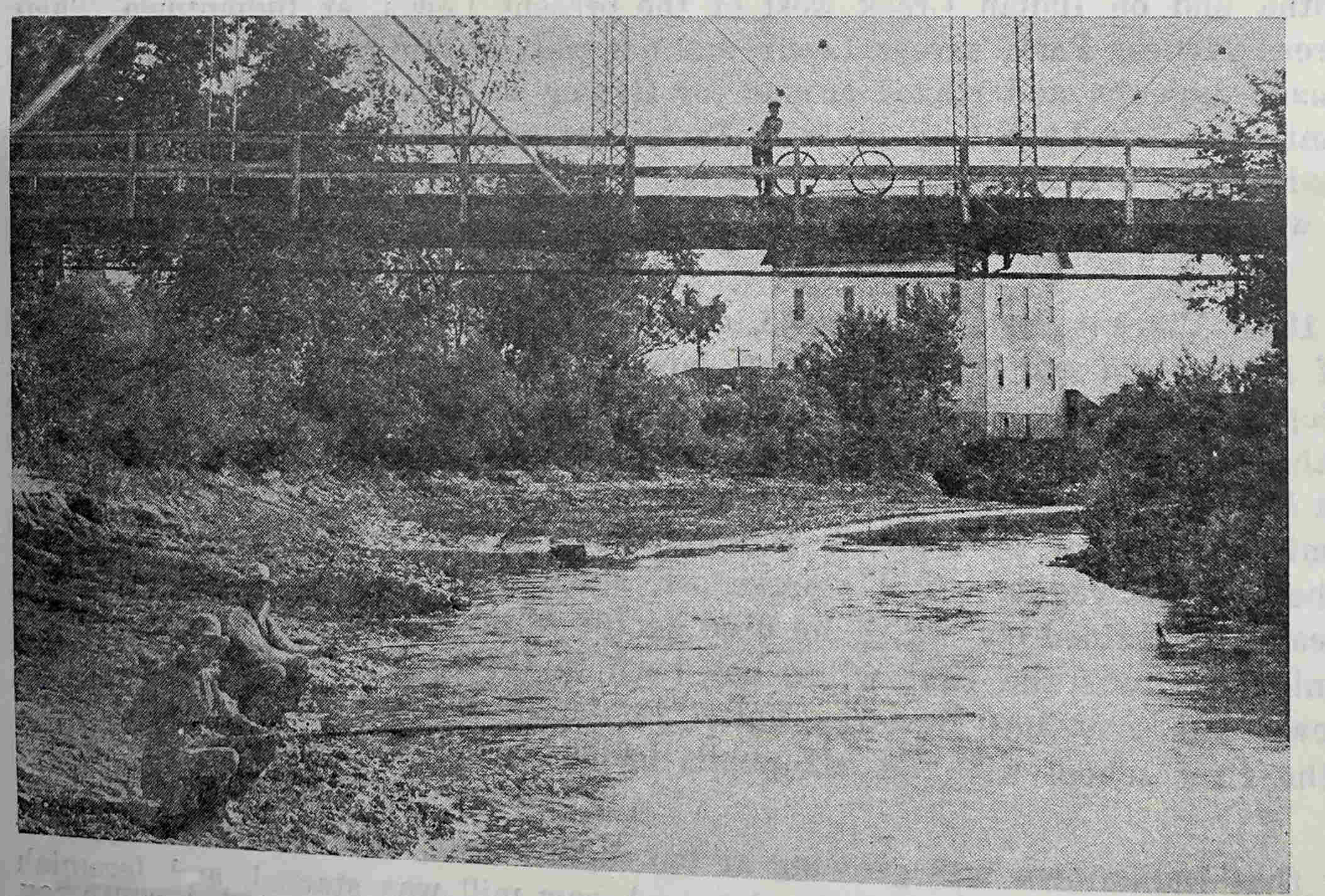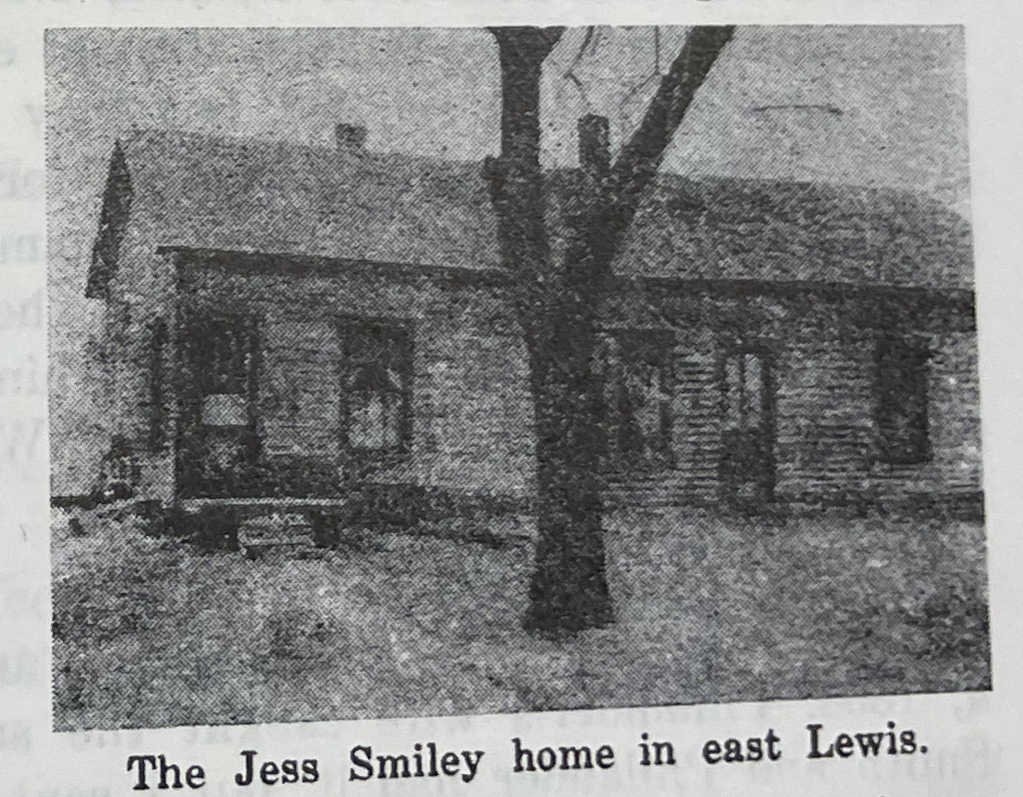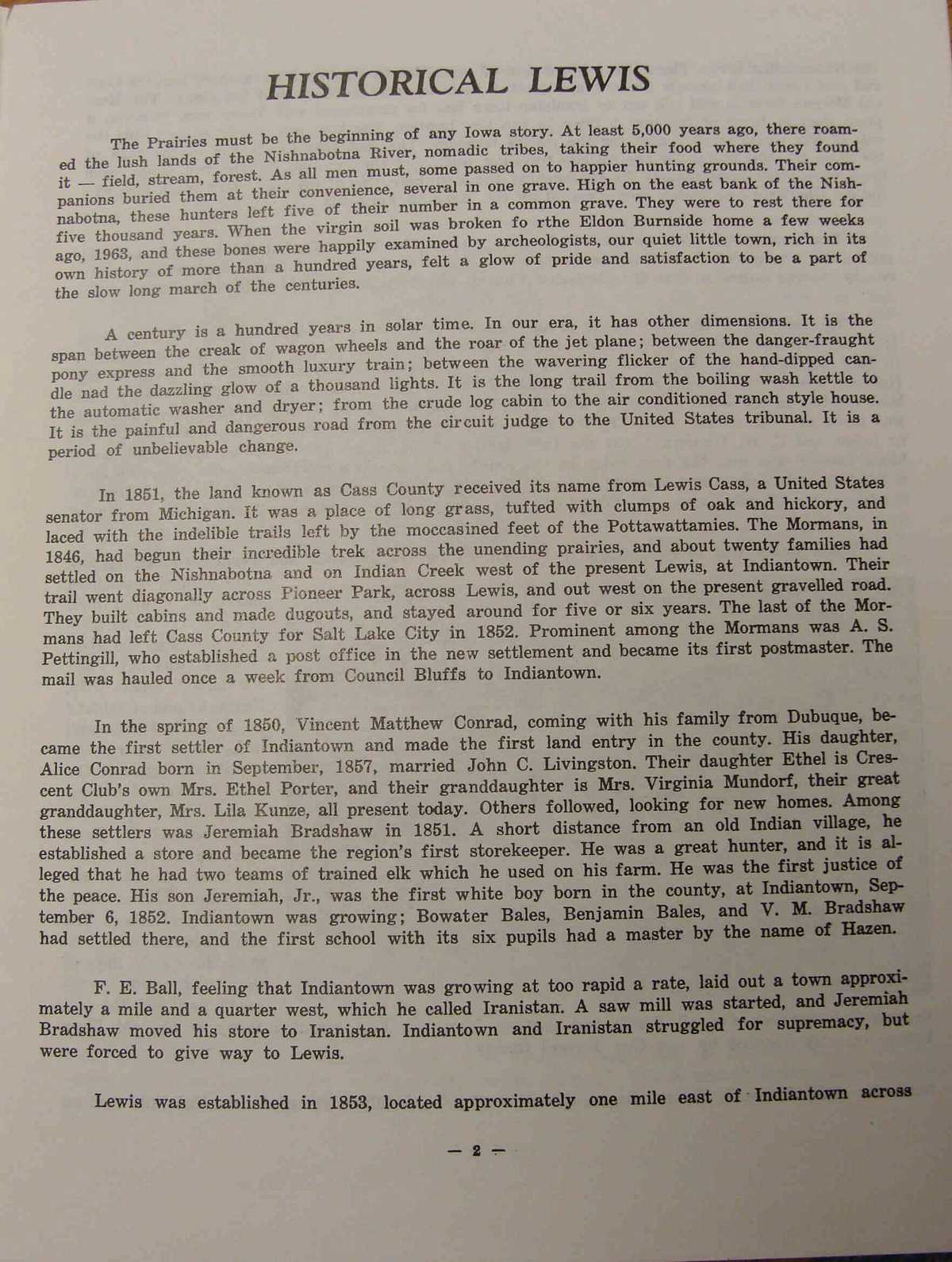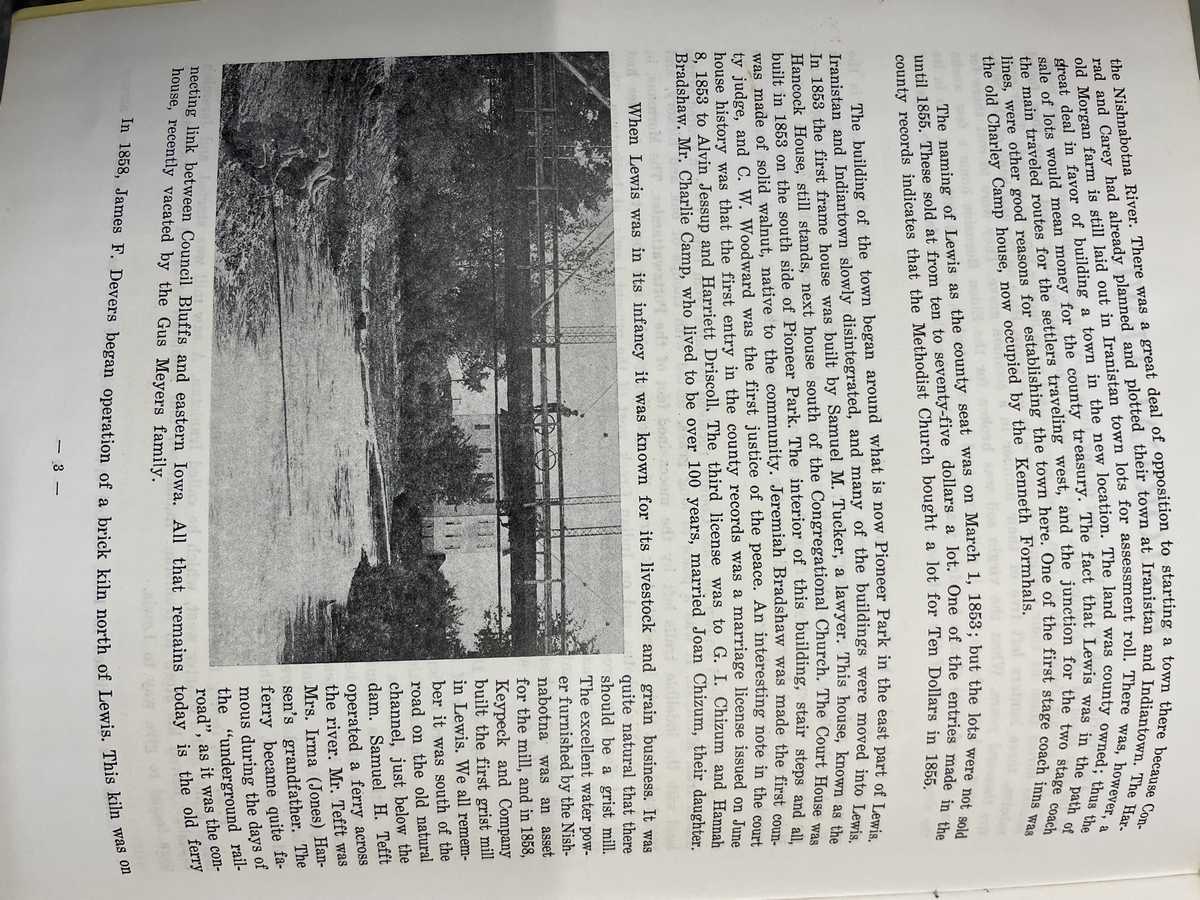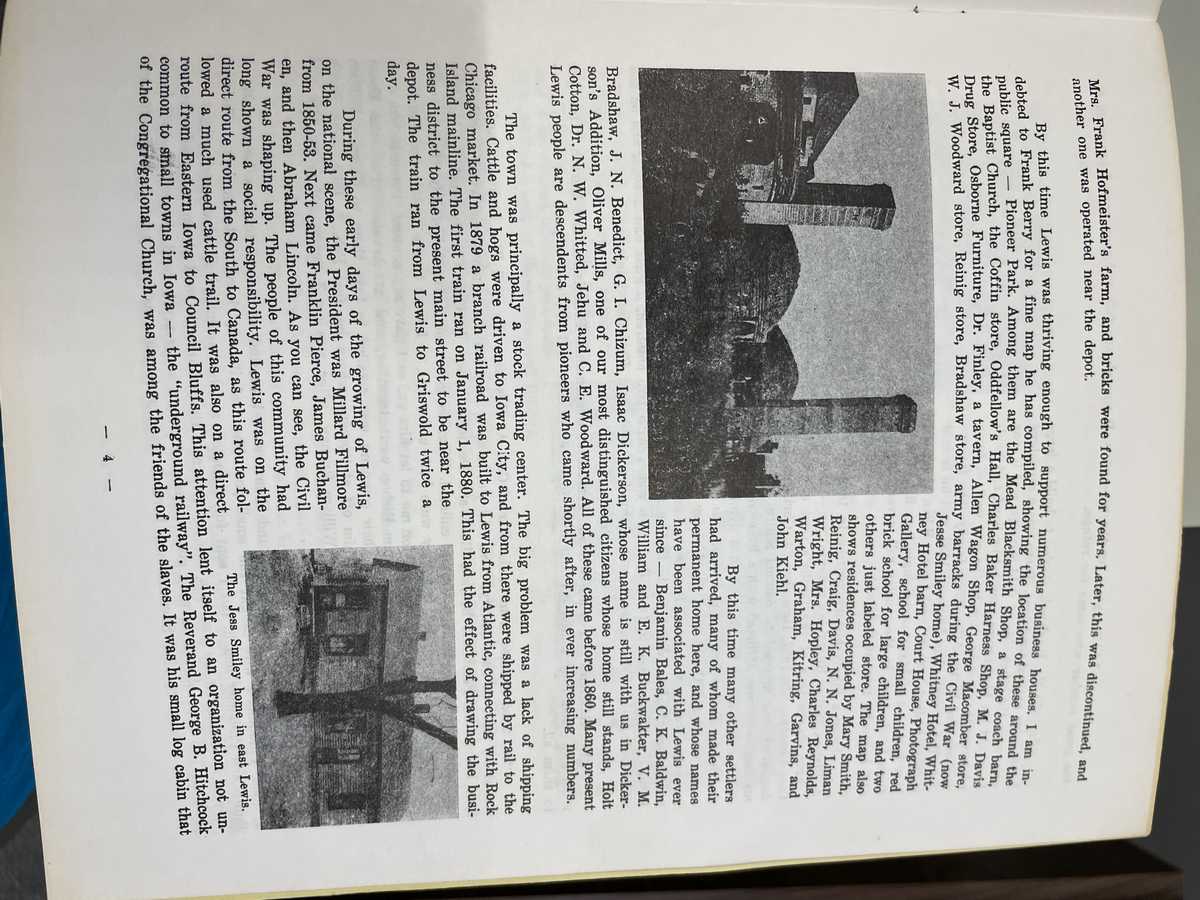HISTORICAL LEWIS
| The Prairies must be the beginning of any Iowa story. At least 5,000 years ago, there roamed the lush lands of the Nishnabotna River, nomadic tribes, taking their food where they found it -- field, stream, forest. As all men must, some passed on to happier hunting grounds. Their companions buried them at their convenience, several in one grave. High on the east bank of the Nishnabotna, these hunters left five of their number in a common grave. They were to rest there for five thousand years. When the virgin soil was brokrn for the Eldon Burnside home a few weeks ago, 1963, and these bones were happily examined by archeologists, our quiet little town, rich in its own history of more than a hundred years, felt a glow of pride and satisfaction to be a part of the slow long march of the centuries. A century is a hundred years in solar time. In our era, it has other dimensions. It is the span between the creak of wagon wheels and the roar of the jet plane; between the danger-fraught pony express and the smooth luxury train; between the wavering flicker of the hand-dipped candle and the dazzling glow of a thousand lights. It is the long trail from the boiling wash kettle to the automatic washer and dryer; from the crude log cabin to the air conditioned ranch style house. It is the painful and dangerous road from the circuit judge to the United States tribunal. It is a period of unbelievable change. In 1851, the land known as Cass County received its name from Lewis Cass, a United States senator from Michigan. It was a place of long grass, tufted with clumps of oak and hickory, and laced with the indelible trails left by the moccasined feet of the Pottawattamies. The Mormans, in 1848, had begun their incredible trek across the unending prairies, and about twenty families had settled on the Nishnabotna and on Indian Creek west of the present Lewis, at Indiantown. Their trail went diagonally across Pioneer Park, across Lewis, and out west on the present gravelled road. They built cabins and made dugouts and stayed around for five or six years. The last of the Mormans had left Cass County for Salt Lake City in 1852. Prominent among the Mormans was A. S. Pettingill, who established a post office in the new settlement and became its first postmaster. The mail was hauled once a week from Council Bluffs to Indiantown. In the spring of 1850, Vincent Matthew Conrad, coming with his family from Dubuque, became the first settler of Indiantown and made the first land entry in the county. His daughter, Alice Conrad born in September, 1857, married John C. Livington. Their daughter Ethel is Crescent Club's own Mrs. Ethel Porter, and their granddaughter is Mrs. Virginia Mundorf, their great-granddaughter, Mrs. Lila Kunze, all present today. Others followed, looking for new homes. Among these settlers was Jeremiah Bradshaw in 1851. A short distance from an old Indian village, he established a store and became the region's first storekeeper. He was a great hunter, and it is alleged that he had two teams of trained elk which he used on his farm. He was the first justice of the peace. His son Jeremiah, Jr., was the first white boy born in the county, at Indiantown, September 6, 1852. Indiantown was growing; Bowater Bales, Benjamin Bales, and V. M. Bradshaw had settled there, and the first school with its six pupils had a master by the name of Hazen. F. E. Ball, feeling that Indiantown was growing at too rapid a rate, laid out a town approximately a mile and a quarter west, which he called Iranistan. A saw mill was started, and Jeremiah Bradshaw moved his store to Iranistan. Indiantown and Iranistan struggled for supremacy, but were forced to give way to Lewis. Lewis was established in 1853, located approximately one mile east of Indiantown across
- 2 -
the Nishnabotna River. There was a great deal of opposition to starting a town there because Conrad and Carey had already planned and plotted their town at Iranistan and Indiantown. The Harold Morgan farm is still laid out in Iranistan town lots for assessment roll. There was, however, a great deal in favor of building a town in the new location. The land was county owned' thus the sale of lots would mean money for the county treasury. The fact that Lewis was in the path of the main traveled routes for the settlers traveling west, and the junction for the two stage coach lines, were other good reasons for establishing the town here. One of the first stage coach inns was the old Charley Camp house, now occupied by the Kenneth Formhals.The naming of Lewis as the county seat was on March 1, 1853; but the lots were not sold until 1855. These sold at from ten to seventy-five dollars a lot. One of the entries made in the county records indicates that the Methodist Church bought a lot for Ten Dollars in 1855. The building of the town began around what is now Pioneer Park in the east part of Lewis. Iranistan and Indiantown slowly disintegrated, and many of the buildings were moved into Lewis. In 1853 the first frame house was built by Samuel M. Tucker, a lawyer. This house, known as the Hancock House, still stands, next house south of the Congregational Church. The Court House was built in 1853 on the south side of Pioneer Park. The interior of this bulding, stair steps and all, was made of solid walnut, native to the community. Jeremiah Bradshaw was made the first county judge, and C. W. Woodward was the first justice of the peace. An interesting note in the court house history was that the first entry in the county records was a marriage license issued on June 8, 1858 to Alvin Jessup and Harriett Driscoll. The third license was to G. I. Chizum and Hannah Bradshaw. Mr. Charlie Camp, who lived to be over 100 years, married Joan Chizum, their daughter. When Lewis was in its infancy it was known for its livestock and grain business. It was quite natural that there should be a grist mill. The excellent water power furnished by the Nishnabotna was an assett for the mill, and in 1858, Keypeck and Company built the first grist mill in Lewis. We all remember it was south of the road on the old natural channel, just below the dam. Samuel H. Tefft operated a ferry across the river. Mr. Tefft was Mrs. Irma (Jones) Hansen's grandfather. The ferry became quite famous during the "underground railroad", as it was the connecting link between Council Bluffs and eastern Iowa. All that remains today is the old ferry house, recently vacated by the Gus Meyers family. In 1858 James F. Devers began operation of a brick kiln north of Lewis. This kiln was on
- 3 -
Mrs. Frank Hofmeister's farm, and bricks were found for years. Later, this was discontinued, and another one was operated near the depot.By this time Lewis was thriving enough to support numerous business houses. I am indebted to Frank Berry for a fine map he has compiled, showing the location of these around the public square -- Pioneer Park. Among them are the Mead Blacksmith Shop, a stage coach barn, the Baptist Church, the Coffin store, Oddfellow's Hall, Charles Baker Harness Shop, M. J. Davis Drug Store, Osborne Furniture, Dr. Finley, a tavern, Allen Wagon Shop, George Macomber store, W. J. Woodward store, Reinig store, Bradshaw store, army barracks during the Civil War (now Jesse Smiley home), Whitney Hotel, Whitney Hotel barn, Court House, Photograph Gallery, school for small children, red brick school for large children, and two others just labeled store. The map also shows residences occupied by Mary Smith, Reinig, Craig, Davis, N. N. Jones, Liman Wright, Mrs. Hopley, Charles Reynolds, Warton, Graham, Kitring, Garvins and John Kiehl. By this time many other settlers had arrived, many of whom made their permanent home here, and whose names have been associated with Lewis ever since -- Bejamin Bales, C. K. Baldwin, William and E. K. Buckwakter, V. M. Bradshaw, J. N. Benedict, G. I. Chizum, Isaac Dickerson, whose name is still with us in Dickerson's Addition, Oliver Mills, one of our most distinguished citizens whose home still stands, Holt Botton, Dr. N. W. Whitted, Jehu and C. E. Woodward. All of these came before 1860. Many present Lewis people are descendents from pioneers who came shortly after, in ever increasing numbers. The town was principally a stock trading center. The big problem was a lack of shipping facilities. Cattle and hogs were driven to Iowa City, and from there were shipped by rail to the Chicago market. In 1879 a branch railroad was built to Lewis from Atlantic, connecting with Rock Island mainline. The first train ran on January 1, 1880. This had the effect of drawing the business district to the present main street to be near the depot. The train ran from Lewis to Griswold twice a day. During these early days of the growing of Lewis, on the national scene, the President was Millard Fillmore from 1850-53. Next came Franklin Pierce, James Buchanen, and then Abraham Lincoln. As you can see, the Civil Was was shaping up. The people of this community had long shown a social responsibility. Lewis was on the direct route from the South to Canada, as this route followed a much used cattle trail. It was also on a direct route from Eastern Iowa to Council Bluffs. This attention lent itself to an organization not uncommmon to small towns in Iowa -- the "underground railway". The Reverand George B. Hitchcock of the Congregational Church, was among the friends of the slaves. It was his small log cabin that |
<== PREV = = = = = = = = = = NEXT ==>
Transcribed by Cheryl Siebrass, June, 2024, from Historical Lewis by Pauline Franklin, pp. 2-4.
Copyright © 1996
The IAGenWeb Project
IAGenWeb Terms, Conditions
& Disclaimer


